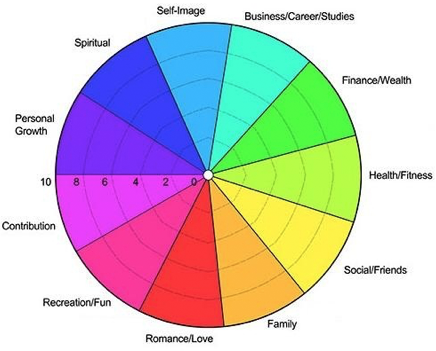If you’ve never heard of a ‘life audit’ then there’s a good chance you’ll really benefit from one. Put simply, it’s an exercise in self-reflection, allowing us to really look at every single area of our lives, taking stock of things like our goals and distractions, and assessing our overall fulfilment.
Now most of us have a pretty good idea of our goals and downfalls anyway, and that self-awareness is certainly necessary for personal growth. What makes a life audit really beneficial however, is that it lets us look at the bigger picture in a much more objective way. This in turn allows us to formulate realistic plans for achieving our goals, improve areas of our lives that may have been neglected, and chase the things that make us feel fulfilled. It’s essentially a status report for your soul – and there’s plenty of ways in which you can do it.
1) The Wheel of Life
Simple visual tools are fantastic for this sort of thing, because they keep your audit from become overwhelmingly complicated. ‘The Wheel of Life’ is arguably the most effective way to gauge the balance in your life and your fulfilment in each key area. It covers all the important things, including self-image, work, friends, romance, and personal growth.

Each colour represents a different area of life, while the concentric circles mark satisfaction levels, from 0 to 10, with 10 being the highest. When you’ve got a few moments print out a copy, and place stickers on the levels that apply to you. Keep it honest. It only takes a short time to do and this exercise can really highlight imbalances that may not have otherwise occurred to you.
2) The Stop, Start, More of, Less of Formula
Putting pen to paper is a proactive way to assess your goals and distractions, and make a personal declaration to achieve or quash them. Lists can easily become a big blur of words however, so it’s best to keep things simple with the ‘Stop, Start, More of, Less of’ formula. Every six months or year, write four lists covering each statement. For example:
Stop
Start
More of
Less of
When you’ve completed your list (and ensure there’s plenty of room to add more things as and when they occur to you) place it somewhere prominent where you can frequently refer back to it and assess your progress (feel free to tick things off as you go). If you want extra motivation, it can also be useful to read the lists first thing each morning, and last thing at night.
3) Post-it Notes Method
Physical notes can resonate more strongly than something in a digital format, because they bring everything back to a more basic, personal, and self-engaging level. What’s more, there’s no risk of falling into a well of distraction courtesy of the internet.
The Post-it note method is ideal for auditing and go-getting, because it allows you to separate short and long term goals, and organise them by priority. Like the ‘Stop, Start, More of, Less of formula’, it also means you get these things out so they’re not swirling about in your mind. Writing each Post-it note is a cathartic exercise in itself.
All you need is a blank wall or a board, and a few pads of Post-it notes. Get to work writing out your goals, hopes, and habits – try to be uninhibited as you can possibly be. When you’re done, sort through them and you’ll begin to notice common themes in the areas of your life that need attention. Create category headers that are relevant to you (for example relationships, or finances) and place each Post-it note underneath them vertically, in order of priority.
What makes this exercise great is that it not only highlights the areas of your life that need attention, but you can also remove the Post-its as and when they no longer apply - giving you a real visual representation of how much you’re achieving.
4) Declutter
Lastly, declutter. There’s a reason ‘tidy house, tidy mind’ is a prominent saying. Clutter weighs you down, distracts you, and creates the perfect breeding ground for stress. The same can also be said of unhealthy friendships, negative relationships, and pastimes that contribute more harm than good. Decluttering every area of your life both physically and mentally can cut the chaos, boost productivity, and make for a more harmonious life – leaving a clear pathway for wherever you’re headed.
How do you set goals, evaluate your achievements and reduce those things that hold you back? Let us know about your own personal audit methods and success stories in the comments below.

The Coaching Academy was established in 1999, and is now the world's largest coaching school.
In that time we have trained over 14,000 people to become life coaches.
We are accredited by the International Coach Federation and the Association for Coaching, and we're rated 4.8 out of 5 on Trustpilot.